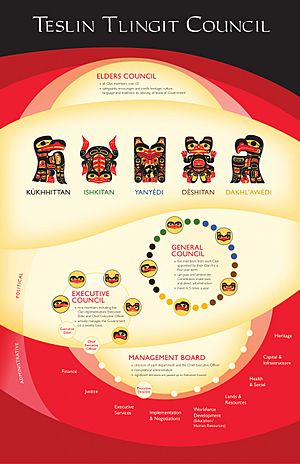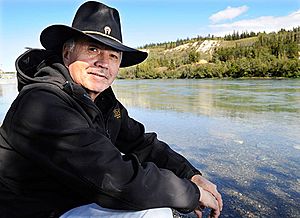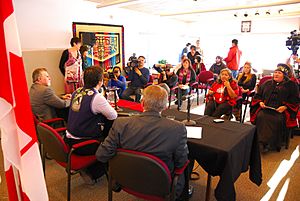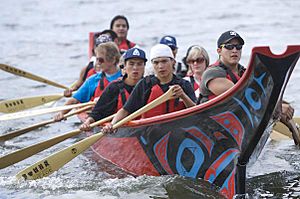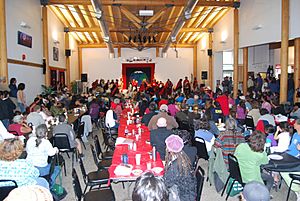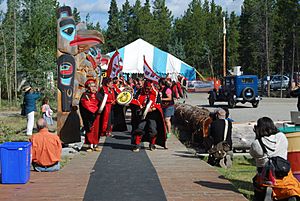Teslin Tlingit Council facts for kids
The Teslin Tlingit Council (TTC) is a First Nation government located in the central Yukon, Canada. They live in Teslin, Yukon along the Alaska Highway and Teslin Lake. The language originally spoken by the Teslin Tlingit people is Tlingit.
The Teslin Tlingit are part of the Inland Tlingit. This group also includes the Taku River Tlingit First Nation from British Columbia. In 1992, the Teslin Tlingit Council was one of the first four Yukon First Nations to sign a land claims agreement. This agreement helped them take back control over their lands and how they govern themselves.
Contents
How the Teslin Tlingit Council is Organized
The Teslin Tlingit Council (TTC) uses a special way to govern. It mixes traditional Teslin Tlingit Clan culture with modern ways of organizing and managing.
The TTC government represents its Clans and all its citizens. It is also responsible for them, much like other democratic governments. The TTC's leaders, who create policies and make sure laws are followed, work closely with the General Council. The General Council makes laws and decides the overall direction of the government.
Clan-Based Government
The Teslin Tlingit Council (TTC) government is built around its traditional Clans. The five Teslin Tlingit Clans are Kukhhittan, Ishkitan, Yanyedi, Deshitan, and Dakhlawedi. Each Clan is very important to the TTC's structure.
One member from each Clan sits on the Executive Council. Also, each Clan chooses five representatives to form the 25-member General Council. Each Clan has a Leader and Elders who are recognized by their Clan.
Executive Council
The Executive Council has nine members. These include the Chief Executive Officer, Deputy Chief, Youth Councillor, one representative from each of the five Clans, and one Elder chosen by the Elders Council. Most members serve for four years.
The Executive Council meets regularly. They make sure the laws and policies approved by the General Council are followed. They also connect the General Council (who makes laws) with the different government departments (who carry out the work). The Chief Executive Officer and other Executive Councillors guide the TTC politically.
General Council
The General Council is the part of the Teslin Tlingit Council (TTC) that makes laws. It has 25 members. There are five representatives from each of the five Clans: Kùkhhittàn, Ishkìtàn, Yanyèdí, Dèshitàn, and Dakhl’awèdí. These members are chosen by their Clans for four-year terms.
The General Council acts for all Teslin Tlingit Citizens. All other TTC government groups report to the General Council and get their instructions from it. This Council is where members discuss, debate, and agree on government business. It is the main decision-making body of the TTC. It has the power to make laws, change the Constitution, approve the yearly budget, and choose Clan representatives for the Executive Council.
The General Council meets several times a year, including a big meeting in the summer. These meetings are open to all citizens and community members.
Elders Council
The Elders Council includes all Teslin Tlingit Elders who are 55 years old or older. Elders are members of this Council for life.
The Elders Council gives advice and guidance to all other parts of the TTC government. They are responsible for protecting, encouraging, and teaching Teslin Tlingit heritage, culture, language, and other traditions.
Chief Executive Officer
Khixhi ka Yelth (Carl Sidney) was born and grew up in Teslin, Yukon. He is a member of the Kukkhittan (Raven Child) Clan. His Grandmother, Yes-ketch (Olive Sidney), raised him in a traditional way. He learned from a young age how to live off the land.
When the TTC's Self-Government Agreement was signed, Carl continued to represent his Clan. He served on the Executive Council for 10 years, including seven years as the TTC's Deputy-Chief. In 2012, Carl was chosen by the TTC General Council to be the Chief for a four-year term.
Past Chiefs
- Sam Johnston (1970 - 1984)
- Robert Lee Jackson (1984)
- Richard Sidney (1984 - 1986)
- Robert Lee Jackson (1986 - 1988)
- Dave Keenan (1988 - 1996)
- Richard Sidney (1996 - 2000)
- Eric Morris (2000 - 2008)
- Peter Johnston (2008 - 2012)
Some other past Chiefs include Frank Sidney, Joe Squam, and William Johnston.
Self-Government for the Teslin Tlingit Council
The TTC's Self-Government Agreement was signed in 1993. This agreement allows the TTC to create its own laws and political system. It helps them work with the governments of Canada and Yukon.
The agreement lists many areas where the TTC can make its own laws. These include:
- How they use and manage their Settlement Lands and the people living on them.
- How they run their own affairs, including the rights and benefits from their Final Agreement.
The laws made by the TTC apply to all Teslin Tlingit Citizens, no matter where they live in the Yukon. This Self-Government Agreement means the TTC is taking on more responsibility for things that used to be handled by the Canadian or Yukon governments.
Self-Justice: Making Their Own Laws Fair
The Administration of Justice Agreement (AJA) recognizes the Teslin Tlingit Council's right to manage justice. This agreement was signed on February 21, 2011, by representatives from the Government of Canada, the Government of Yukon, and the TTC. It was the first agreement of its kind in Canada. This put the TTC at the forefront of self-governing Indigenous groups in the country.
The AJA means that some areas of justice will use traditional Teslin Tlingit ways of solving problems. The agreement gives the TTC the power to:
- Set penalties for breaking TTC laws.
- Appoint people to enforce and prosecute violations of these laws.
- Set up a Peacemaker Court to decide on violations and review decisions made by TTC officials.
The Administration of Justice Agreement started on November 24, 2011, with the new Peacemaker Court and Justice Council Act. The TTC's Justice Council is very important in carrying out this agreement. They appoint Peacemakers to lead court proceedings.
Teslin Tlingit Council Departments
The Teslin Tlingit Council's daily work is handled by nine different departments:
- Executive Services: This department helps with the internal organization, research, developing policies and laws, and communications.
- Finance and Administration: They manage money, register citizens and records, and handle IT.
- Health & Social Development: This team works to improve community wellness, provides support services, and manages early learning and child care.
- Lands & Resources: They are in charge of managing and protecting wildlife and resources on Teslin Tlingit Traditional Territory.
- Capital & Infrastructure: This department takes care of and develops the TTC's buildings and other important structures.
- Heritage: They manage the Teslin Tlingit Heritage Centre, protect important historical sites, organize cultural celebrations, and promote the Tlingit language and culture.
- Negotiations & Implementation: This team works on continuing negotiations and carrying out the TTC's treaties and agreements with the Canadian and Yukon governments.
- Justice: They put into action and manage the TTC's Administration of Justice Agreement. This includes training Peacemakers and organizing the Peacemaker Court.
- Workforce Development: This department helps with community development through education support and training. They also handle the TTC's Human Resources.
Teslin Tlingit Heritage and Culture
Teslin Tlingit people are Inland Tlingit. They traveled from the coast of southeast Alaska to the interior plains of the Yukon in the early 1700s. Before permanent settlements were built with the Alaska Highway in 1942, Teslin Tlingit people lived by fishing, hunting, and gathering.
Today, hunting and gathering are still a big part of Teslin Tlingit culture. Elders teach traditional knowledge to Tlingit youth at harvest camps.
Citizenship
Being a Teslin Tlingit Council (TTC) Citizen is based on family lineage and traditional customs. It does not follow the Canadian government's definition of "Status." Currently, there are about 800 Citizens. About 300 live in Teslin Village, 300 in Whitehorse, and 200 in other parts of North America.
Tlingit Language
The Tlingit language is related to Eyak, a language that is no longer spoken. Today, Tlingit is spoken in the Yukon communities of Teslin and Carcross. It is also spoken in the Atlin area of British Columbia and in coastal towns along the Alaskan panhandle. Even though the language is spoken over a wide area, speakers can generally understand each other.
The TTC's Heritage Department offers Tlingit language and culture programs. These programs help young Teslin Tlingit people learn the language. They also set up mentorships for advanced learners and create chances for people to share Tlingit language skills in traditional settings.
Ha Kus Teyea Celebration
Every two years in the summer, the Ha Kus Teyea Celebration is held at the Teslin Tlingit Heritage Centre. The Inland Tlingit nations, including Teslin Tlingit Council, Carcross/Tagish First Nation, and Taku River Tlingit First Nation, host this event. Tlingit people from places like Juneau, Angoon, and Sitka travel to Teslin for this celebration. It helps connect Inland and Coastal Tlingit people.
Ha Kus Teyea means 'Our Way'. It describes what makes the Teslin Tlingit who they are. It includes their shared knowledge, language, art, history, and their connection to their environment.
Teslin Tlingit culture developed from their history of moving from the coast to the interior. The coastal Tlingit culture from southeast Alaska was brought inland about 300 years ago. Even though the Inland Tlingit mixed with their Athapaskan neighbors, Tlingit traditions, culture, and social patterns stayed strong. Today, Inland Tlingit and Coastal Tlingit people celebrate Tlingit culture together through the Ha Kus Teyea Celebration.
Indian Reserves
The Teslin Tlingit Council also manages these Indian Reserves:
- Nisutlin Indian Reserve No. 14, 83.90 hectares.
- Nisutlin Bay Indian Reserve No. 15, 0.5 km southeast of Teslin, 50 hectares.
- Teslin Post Indian Reserve No. 13, 27.60 hectares.


